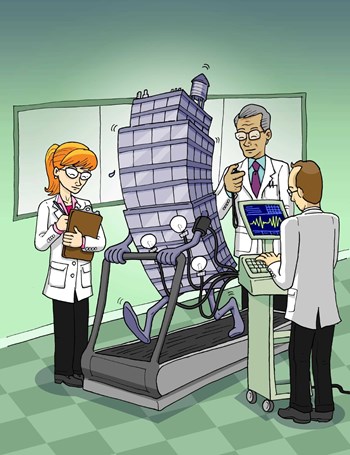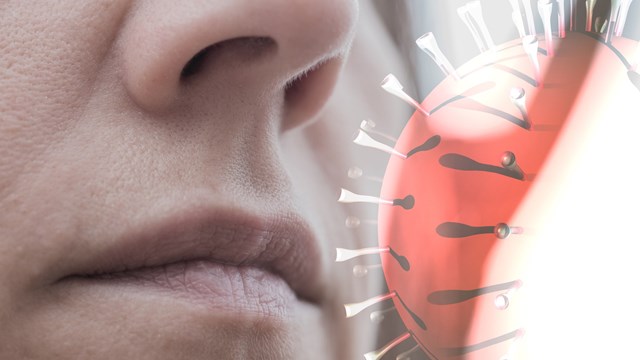
While most people might catch the flu in the winter or suffer from allergies in the spring, a building’s immune system is continually being tested. An environment that appears “healthy” on the surface could be plagued by invisible, odorless elements hazardous to the health of the occupants.
But what exactly is sick building syndrome (SBS)?
“Sick building syndrome is a term often used to refer to a variety of non-specific concerns such as headache, fatigue and mucus membrane/eye irritation,” says Rob Rottersman MS, CIH, a senior manager at the Chicago-based company Environ. “While these concerns will be present at some level in every building, in cases with SBS they may occur at higher than normal rates or symptoms that will resolve with time away from the building.”
Ian Cull, P.E. for the Chicago-based company Indoor Sciences explains that “syndrome” can be a misleading word presenting managers and board members with a confusing explanation of events. “The very phrase ‘sick building syndrome’ has fallen out of favor perhaps because the word ‘syndrome’ refers to not knowing what is causing the problem and therefore the problem might be considered not a big deal.”
Cull says that often a more appropriate explanation is Building Related Issues (BRI). Rottersman adds that BRI shouldn’t be used interchangeably with SBS because this diagnosis usually includes a “documented clinical disease and a building related factor linked to the disease.”
History and Causes
The concept of investigating a building's health was almost unheard of prior to 1980. For example, the U.S. Consumer Product Safety Commission only banned the use of lead paint in 1977. By 1984, the World Health Organization (WHO) committee released a report which found that up to 30 percent of new and remodeled buildings worldwide could be the subject of excessive complaints related to indoor air quality (IAQ).
According to the Environmental Protection Agency’s (EPA) Indoor Air Quality division, both SBS and BRI can be temporary although certain buildings have longer-term problems. “Frequently, problems result when a building is operated or maintained in a manner that is inconsistent with its original design or prescribed operating procedures. Sometimes indoor air problems are a result of poor building design or occupant activities,” states the EPA.
The EPA further defines SBS and BRI by providing a list of associated symptoms. For the former, causes are not known and usually dissipate after a person leaves the building. Whereas BRI has discernible variables and often the person requires extended time (or medical attention) away from the building before symptoms subside.
Indicators of SBS include occupants of the building complaining of symptoms associated with acute discomfort such as headache, eye, nose or throat irritation; dry cough, dry or itchy skin; dizziness and nausea; difficulty in concentrating; fatigue and sensitivity to odors. Indicators of BRI include occupants of the building complaining of symptoms such as cough, chest tightness, fever, chills and muscle aches.
By the 1990s, diagnosing the cause of irritants and sickness in a building became commonplace. As a result, regulations and legislation on a variety of known irritants such as asbestos and lead paint were put into place although there are currently no regulations specific for indoor air quality. To ensure that buildings were operating at the safest possible levels for occupants and employees, new businesses adept at addressing SBS and BRI concerns sprung up all over the nation.
Still, today, the World Health Organization found that 64 million Americans or approximately 50 percent of the workforce have complained of SBS-style symptoms. Twenty-three percent of those 64 million report that their symptoms improve after leaving their work environment. While these statistics don’t specifically address co-ops and condominiums, it is safe to assume that many buildings have hidden, potentially hazardous conditions.
Despite statistics and facts, vendors and professionals say that they are often contacted only when a problem is detected which makes matters worse for tenants and can cost more in the long run.
“Taking precautionary steps is the best way to approach any building,” says Bruce Sanders, president of the Chicago-based company Air Care Services. “I travel all over the country attending seminars on these topics and what I’ve seen and heard time and time again is that few buildings take preventative measures. You would think Chicago would be more progressive in this regard but we see that even in this great city, people do not pay for prevention and that only causes bigger problems down the line.”
Is Your Building at Risk?
While older buildings could be more susceptible to SBS and BRI issues, virtually all buildings can be deemed “sick” resulting from deficiencies in cleanliness, damp building materials and poor or improper ventilation.
“Urban areas may have more concerns related to vehicle exhaust, combustion byproducts or industrial emissions. Rural buildings may have higher levels of background allergens such as mold spores and pollen,” says Rottersman. “However, these factors are related to where the building was constructed and not necessarily the building itself.”
Aside from the silent, odorless irritants, there are some preventable measures a proactive management company or aggressive board can take to determine the general health of the building—a visual inspection and a sniff test. Common risk factors include water staining, visibly apparent mold growth, abnormal dust accumulation and closed outside air dampers.
“Often it is the odors associated with chemical products including cleaning and painting that cause the concern. In the vast majority of cases chemical exposures do no rise to the level that would result in adverse health outcomes, however, the odors from the chemicals may result in the non-specific complaints that are associated with sick building syndrome,” says Rottersman. “If odors are persistent, complaints can be expected.
Taking Control
Along with guidelines put forth by the EPA, there are organizations that offer guidance including the National Air Duct Cleaners Association (NADCA) that certifies companies in best practices. For duct work and all HVAC systems, NADCA recommends inspection every two years. “This is not to have it cleaned every two years just inspected,” notes Cull. “This can be done in-house.”
A “civilian” trained eye can handle the inspection and notice things such as mold, rodents or blockages which require immediate cleaning, however, too much cleaning can be an issue. “There is debate on how often to clean if these problems aren’t found,” says Cull. “If there is a little dusting in the ducts it could be argued that there is no health benefit to cleaning when it is not a extreme case.”
Cull says that an “ounce of prevention is worth a pound of cure” but he adds, like Sanders, “that nine out of ten times the phone only rings when there is a problem.” He suggests that a co-op or condo association invest in basic inexpensive equipment that can test air temperature and humidity. “A professional should be hired when there is a complaint made and there is concern. If there is a budget for it, it makes sense to do an annual checkup of all operating systems.”
As is the case with all industries, professionals that are hired to determine and address SBS or BRI issues have to be well-versed in all aspects of cleaning and maintenance. This is often hard for a hiring agent such as a board to understand since they aren’t physically climbing through the duct work or seeing inside the walls.
“My industry is very strange because there is so much misinformation provided by companies that are not reputable or certified,” says Sanders. He cited examples such as companies underbidding professional outfits and simply cleaning two or three feet of duct work with Shop-vacs at entry points rather than the entire system. “You have to do your research and see what these companies have done by speaking with their clients. It’s a process,” says Sanders.
A building with multiple units has exponential possible irritants which make a one-size-fits-all evaluation or a silver bullet test nearly impossible. If a building were to sample and test volatile organic compounds (VOCs), formaldehyde, airborne dust levels, mold, dust mite allergen, cat allergen and legionella bacteria, for example, large laboratory fees would result. “It is much more efficient to gain an understanding of the building and the concern then focus testing in a more targeted approach that can help answer questions and direct follow-up action to help resolve concerns,” says Rottersman.
The key to understanding what risks may exist is to have a firm understanding of all operations within the building. This includes reviewing the ventilation system to determine how air is distributed and if there are zones in the buildings served by different ventilation systems. Concerns or complaints by occupants should be recorded and filed. Management companies and board members should have a file detailing the history of the building to identify potential risk factors which usually include the location of applied chemical products and water infiltration areas such as crawlspaces, kitchens and showers.
Attention to detail, scheduling and due diligence is considered half the battle. By repairing leaks, moisture will be removed from trouble spots such as sinks and kitchen vents. Since there is relative high humidity during the long, cold Chicago winters, condensation is common on internal surfaces. While humidifiers and DE-humidifiers are recommended, depending on the residence, they can both be a reservoir for microbial growth if not properly maintained and cleaned frequently.
Even with oversight SBS and BRI issues will inevitably arise. In such cases, who is at fault? “Building exposures and health outcomes can be very difficult to prove or disprove. This has resulted in a substantial amount of claims in civil court where only a preponderance of evidence is required to win a case,” says Rottersman. “This can be costly when claimed health outcomes are involved. The best defense is being able to demonstrate a proactive program to maintain a healthy building.”
W.B. King is a freelance writer and a frequent contributor to The Chicagoland Cooperator.






Leave a Comment